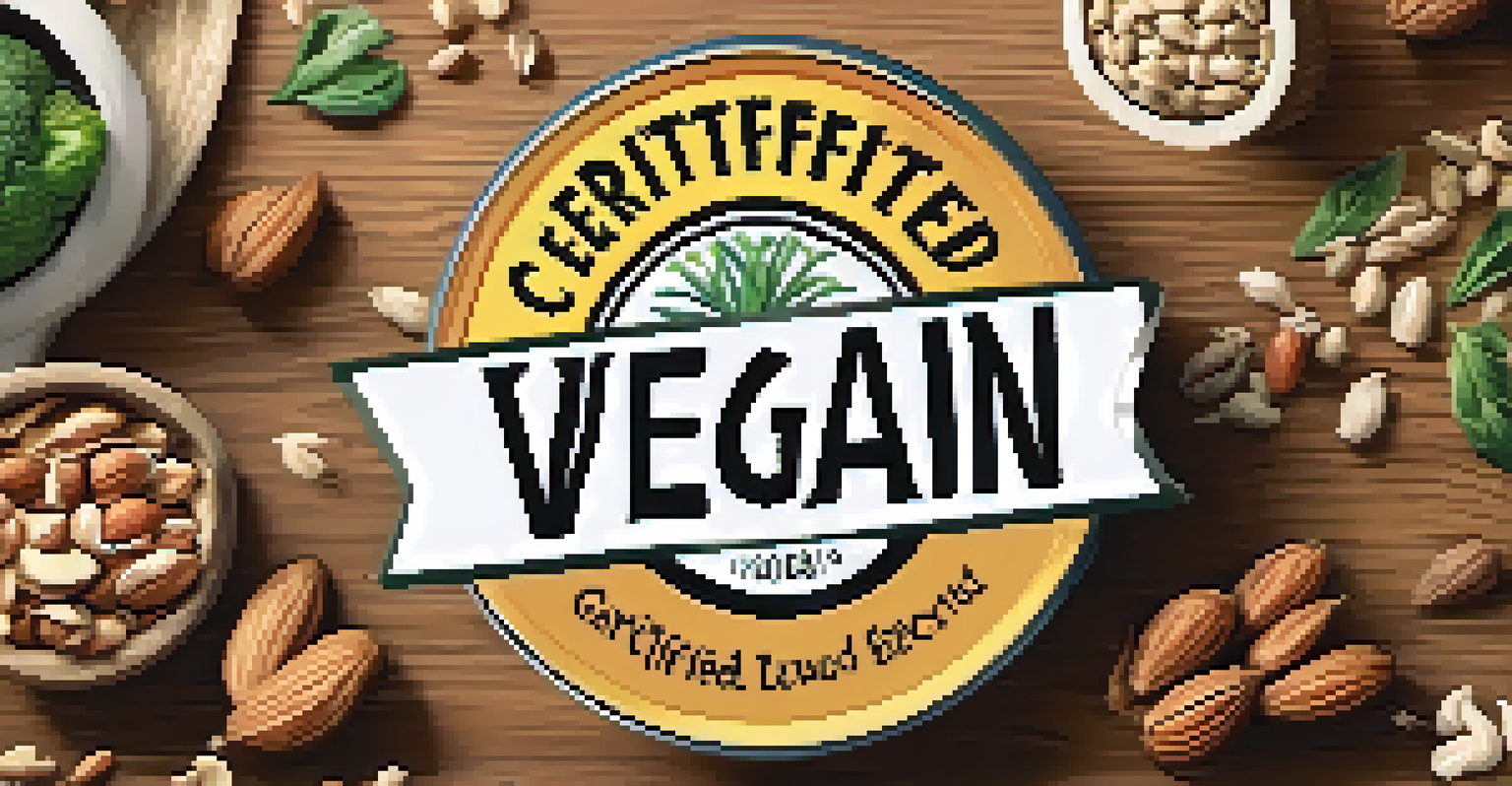How to Read Labels for Vegetarian-Friendly Products

Understanding Vegetarian Labels and Terms
Navigating the world of product labels can be tricky, especially for vegetarians. Terms like 'vegetarian,' 'vegan,' and 'plant-based' often appear, but they don't always mean the same thing. For example, a product labeled 'vegetarian' may still contain dairy or eggs, while 'vegan' means it has no animal products at all.
Eating meat is a decision, but being a vegetarian is a lifestyle.
It’s essential to familiarize yourself with these terms to make informed choices. Some brands may also use phrases like 'meat-free' or 'contains no meat,' which can be misleading if they still include animal-derived ingredients. Understanding these nuances helps you avoid potential dietary pitfalls.
When shopping, always look for certified labels. Many products have a vegetarian or vegan certification symbol, making it easier to identify items that meet your dietary needs without having to scrutinize every ingredient.
Reading Ingredient Lists: What to Look For
Ingredient lists are the heart of any product label, but they can be overwhelming. Start by scanning for common animal-derived ingredients, such as gelatin, rennet, and casein, which are often hidden. These ingredients are frequently found in snacks, desserts, and dairy products, so it's wise to be vigilant.

Additionally, ingredients like honey and certain colorings (such as carmine) can also be animal-derived, which might surprise some consumers. If you're unsure about an ingredient, a quick search can provide clarity and help you decide if it's suitable for your diet.
Know Your Vegetarian Terms
Understanding the differences between labels like 'vegetarian,' 'vegan,' and 'plant-based' is crucial for making informed dietary choices.
Remember, ingredients are listed in order of quantity, so if you see a questionable item near the end, it may not be a dealbreaker. However, if it’s at the top, you might want to think twice before purchasing.
Identifying Hidden Animal Products
Many products contain hidden animal ingredients that aren't immediately obvious. For instance, some processed foods might use animal fats or broths, which aren't always listed clearly. This is where knowledge of common additives comes in handy—being aware of terms like 'natural flavors' can save you from surprises.
The greatest threat to our planet is the belief that someone else will save it.
Another sneaky culprit is cross-contamination, especially in processed foods. A product might be made in a facility that handles meat, which could pose a concern for strict vegetarians. Always check for any disclaimers on the packaging about shared equipment.
Being proactive by researching brands known for vegetarian-friendly practices can make your shopping experience smoother. Many companies are transparent about their ingredients, allowing you to choose products with confidence.
Exploring Certification Labels
Certification labels can be a vegetarian's best friend when it comes to choosing products. Look for seals from reputable vegetarian organizations, which indicate that the product meets strict vegetarian standards. These certifications can save you time by eliminating the need for detailed ingredient checks.
Different certifications have varying criteria. For example, a 'Certified Vegan' label means no animal products were used at any stage of production, while a 'Vegetarian Society Approved' label allows certain animal-derived ingredients. Understanding these distinctions can guide your shopping.
Check Ingredient Lists Carefully
Always read ingredient lists for hidden animal products to avoid surprises and ensure your food aligns with your dietary preferences.
Don't hesitate to rely on these certifications as a quick reference. They act as a shortcut to identifying products that align with your dietary choices, making it easier to fill your cart with items that fit your lifestyle.
Navigating Store Layouts for Vegetarian Options
Understanding store layouts can make your shopping experience more efficient. Many grocery stores now have dedicated sections for vegetarian and vegan products, making it easier to find suitable options. Familiarizing yourself with these areas can save time and reduce the stress of searching through aisles.
Additionally, don't overlook the produce section. Fresh fruits, vegetables, legumes, and grains are the backbone of a vegetarian diet. Building your meals around these whole foods ensures you're getting the nutrients you need while keeping things simple.
It can also be helpful to ask store staff for recommendations on vegetarian-friendly products. Many employees are knowledgeable and can guide you to new items you might not have noticed otherwise.
Using Online Resources for Better Choices
The internet is a treasure trove of information when it comes to vegetarian products. Numerous websites and apps can help you scan barcodes and identify whether a product aligns with your dietary needs. These tools can be particularly useful when you're in-store and need a quick reference.
Social media platforms and online communities also provide valuable insights. Joining vegetarian groups can connect you with like-minded individuals who share product recommendations, recipes, and tips. Engaging within these communities can enhance your shopping experience and broaden your culinary horizons.
Utilize Certification Labels
Relying on reputable certification labels can simplify your shopping experience by quickly identifying vegetarian-friendly products.
Don’t hesitate to explore blogs and websites dedicated to vegetarianism. They often provide comprehensive lists of vegetarian-friendly brands and products, helping you make informed choices before you even step into a store.
Keeping Up with Trends and New Products
The vegetarian market is constantly evolving, with new products and trends emerging regularly. Staying informed about these changes can help you discover exciting options that fit your diet. Subscribe to newsletters from vegetarian brands or follow them on social media to stay in the loop.
Additionally, many grocery stores have seasonal offerings and limited-time products that may be vegetarian-friendly. Being aware of these can add variety to your meals and keep your diet interesting. Don't be afraid to experiment with new flavors and textures!

Lastly, consider trying out local vegetarian or vegan businesses. They often offer unique products that might not be found in larger stores, and supporting local businesses can be gratifying. Keep an open mind, and you might just stumble upon your new favorite snack or meal.
Empowering Yourself Through Knowledge
Ultimately, the key to confidently reading labels for vegetarian-friendly products is education. The more you know about ingredients, certifications, and trends, the better equipped you'll be to make choices that align with your values. Embrace the learning process as you navigate the aisles.
Remember, it's okay to ask questions and seek clarity. Whether it's reaching out to a brand for more information or chatting with fellow vegetarians, sharing knowledge can enhance your understanding and experience. You're not alone in this journey.
By fostering a mindset of curiosity and empowerment, you can transform grocery shopping from a daunting task into an enjoyable adventure. Each shopping trip is an opportunity to learn something new and make choices that support your vegetarian lifestyle.